Monday, June 21:
Yesterday turned out to be a very long day, again. The morning tour covered the smaller palace on the Baltic Sea - Petrovorets Grand Palace which included a 100 square hectare park. It's about 200 km. wide and 1/2 km. deep. This is the palace with the Grand Cascade - fountains which go on as far as the eyes can see. This palace also was ravaged by the Nazi's during the war, all of the structures and some of the furniture are renovations, rather than originals. The great halls are beginning to all blur in my mind, it's so very massive a scale.
We took a hydrofoil across the Neva back to the Hermitage and realized what a grand entrance Peter must have had into the city proper from his palace.
Later, upon returning from town, we went through the industrial district which has large Stalin-era smoke-stack factories that are simply rusting away -- being about 50 years obsolete. Productivity of the country must be a fraction of capacity from a casual view. They said in one Q & A session that true unemployment is 50% because workers go to work perhaps one or two days a week, just to check in to be eligible for their paycheck, should anyone decide to actually pay them. One guide said her husband had been unemployed for the past 10 years. Another guide reported that many people were taking English lessons as opposed to more technical training, in order to find employment in the service/tourist sector.
In the afternoon of Sunday, they left us at the Church of our Savior of the Spilt Blood, the site where they killed Tzar Alexander who freed the serfs in 1861. Across the street is a nice "flea market" with the same souvenir collection as elsewhere in the city. I would like to have seen more artisan collections - or outlets for craft specialties rather than these hoards of merely the same trinkets as everywhere else. There's a uniformity that suggests mass production and discouraged me from buying.
For a couple of hours we walked up and down Nevskiey Prospect -- something of a Fifth Avenue for St. Petersburg. The boulevard is long and so wide that, at some points, it's wiser to have underground crossing for pedestrians rather than above ground. Down below, it's much like NY or LA -- pensioners begging out of the sun, a few drunkards doing unmentionable things and entrepreneurs selling flowers, lace, or matroshkas -- a true 100% corner.
In our walkings, we came across a small commercial redevelopment project on Nevskiey Prospect call The Atrium. I'm sure this is one example of what Russians jealously regard as a "mafia" project. The probably suspect the origins of the funding, while we are impressed by the result. It's a small commercial coffee shop with three clothing stores facing in on the atrium. Modern clothing for men, women, and families, apparently imported from Denmark, Finland, and Sweden. Multi-lingual clerks are uniformly dressed throughout The Atrium -- green colors, both male and female. Little flags on their lapels indicate the languages they speak. Clothing is reasonably priced. Even an elevator for the three story office building in back. Nice public bathrooms. Security guards in front.
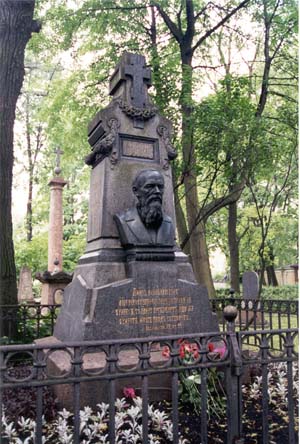
Tikhvin Cemetery at Alexander Nevskiey Monastery - Theodore Dosteovsky
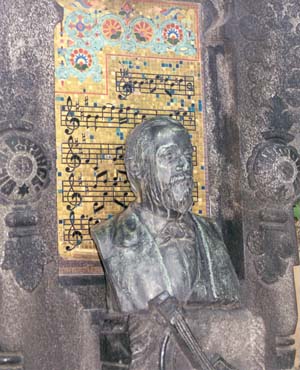
Tikhvin Cemetery - Nikolai Andreavich Rimsky-Korsokov, 1844-1908 - Director of the St. Petersburg Conservatory
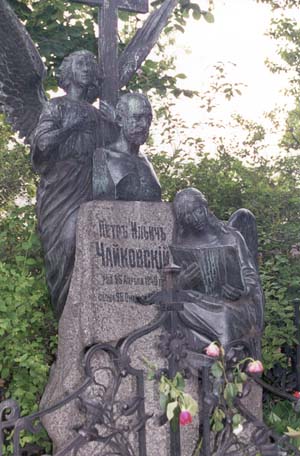
Tikhvin Cemetery - Petr Ilychi Tchaikovsky, 1840-1893
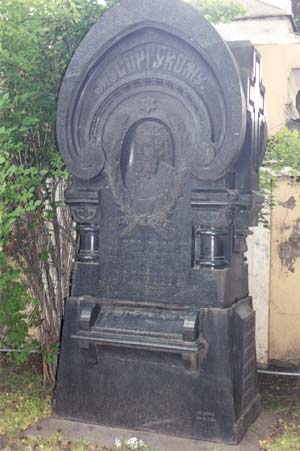
Tikhvin Cemetery - Modest Petrovich Moussorgsky, 1835-1881
The last morning of our trip, we were bused about, first to Menchikov's House -- Peter the Great's bosom drinking and whoring buddy -- then to Tikhvin Cemetery at Alexander Nevskiey Monastery where Russia's great poets and musicians are buried. It's am impressive sight to see monuments to so many truly great classicists, and then realize how many were of the truly great WERE Russian.
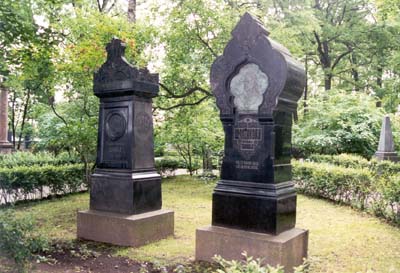
Tikhvin Cemetery - Mikhail Glinka, 1803-1857, and Aleksander Porfirevich Borodin, 1834-1887
We bused to the monument of Peter the Great where 75% of the rock is below ground. There was a Russian with a tiny Bruin Bear on a leash, with whom we took the last group photo.
Finally, we are off to Amsterdam and back to Los Angeles. Two weeks not to be forgotten. Much more yet to be learned of both Russia and the former Soviet republics.
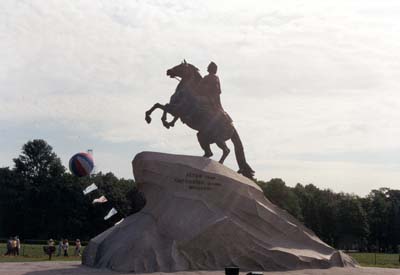
The Bronze Horseman - monument to Peter the Great - 1766-82

